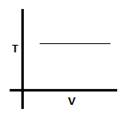Test: Thermodynamic Processes - NEET MCQ
15 Questions MCQ Test Physics Class 11 - Test: Thermodynamic Processes
Heat is supplied to the gas, but its internal energy does not increase. What is the process involved?
| 1 Crore+ students have signed up on EduRev. Have you? Download the App |
Find the final temperature of one mole of an ideal gas at an initial temperature to t K.The gas does 9 R joules of work adiabatically. The ratio of specific heats of this gas at constant pressure and at constant volume is 4/3.
In an adiabatic process gas is reduced to quarter of its volume. What would happen to its pressure? Given ratio of specific heats γ= 2
In an open system, for maximum work, the process must be entirely
Molar specific heat of a substance denoted by symbol C does not depend upon
Two gases X and Y kept in separate cylinders with same initial temperature and pressure are compressed to one third of their volume through isothermal and adiabatic process respectively. Which gas would have more pressure?
In which of the following processes is heat transfer equal to zero?
Which of the following variables is zero for a cyclic process?
Isothermal process can be represented by which law?
Calculate the work done by the gas in an isothermal process from A to B. PA = 1Pa, VA = 3m3, PB = 3Pa.
|
97 videos|378 docs|103 tests
|


















